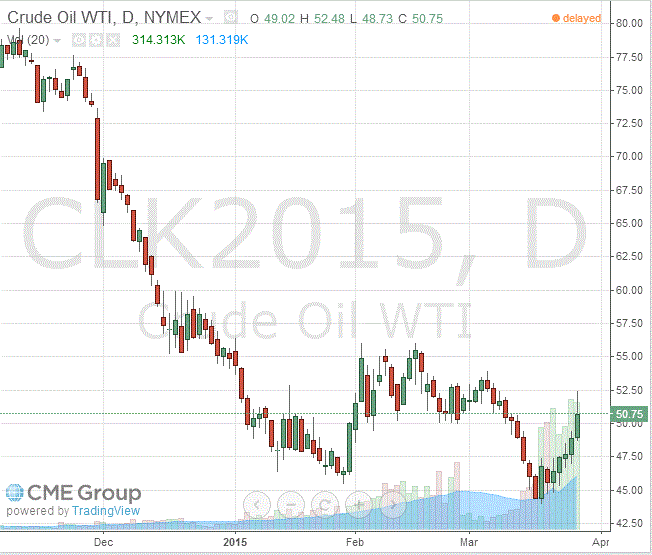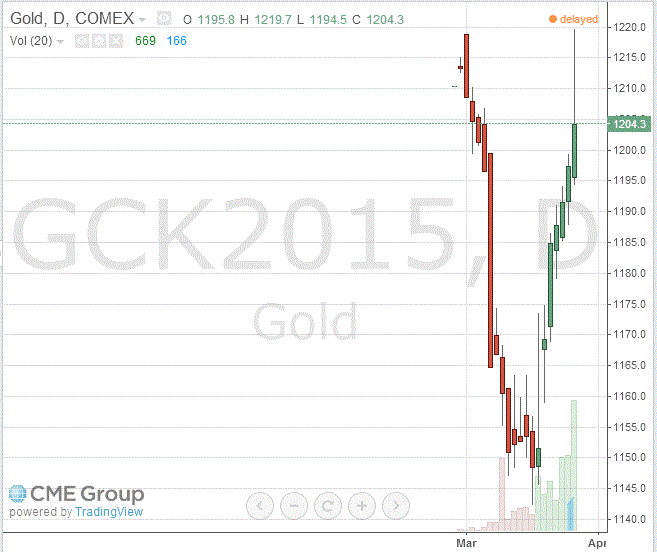Noticias del mercado
-
17:40
Oil: а review of the market situation
Oil prices have increased significantly today, adding about 5%, which was associated with the news that Saudi Arabia and its allies inflicted airstrikes on Yemen. However, later on oil lost almost half earned position, which was partly due to the growth of the dollar against other major currencies during the US session. Analysts believe that the sharp rise in the cost of raw materials to the news of Yemen was most likely caused by excessive activity of players.
Recall that in Yemen hosts international military operation, which involves a number of countries in the region. It is known that the air strikes were carried out at the airport of the capital of Yemen Sana'a and a number of military installations. The operation began immediately after the statement of the Cooperation Council for the Gulf States, which noted that Saudi Arabia, Kuwait, Bahrain, the United Arab Emirates and Qatar intend to respond to the request of President Hadi and protect the legitimate authority in Yemen by militants Huthis. Analysts fear that the military operation may be delayed and escalate into a regional conflict. Although Yemen is not a major supplier of oil, it is next to the Bab-el-Mandeb Strait - one of the main ways tankers. Tankers that cross the Suez Canal, also pass through the Bab-el-Mandeb. Overlapping Strait block the path of tankers from the Persian Gulf to the Mediterranean through the Suez Canal, as well as close the shortest route from North Africa to Asia. However, experts note that an excess of oil on the world market is preserved, this should not worry about the lack of oil. "Just because of the fact that Saudi Arabia and other countries began air strikes, the market will not lose a sudden oil," - said analyst Newedge Japan Masaki Suematsu.
Little impact on the course of trading yesterday also provide data on oil reserves in the United States. Recall the week March 14-20 oil reserves rose by 8.2 million barrels to 466.7 million barrels, while analysts' average forecast assumes an increase of 5.6 million barrels. Commercial US crude stocks remain at historical highs over the past 80 years. Oil reserves in Cushing terminal rose by 1.9 million barrels to 56.3 million barrels. This is a new historical high since April 2004. Worries about rising inventories of oil in storage in the United States this month, putting pressure on prices. A steady increase in oil production in the United States against the backdrop of sluggish demand reinforces the view of the imminent exhaustion of oil storage capacity of some.
May futures for US light crude oil WTI (Light Sweet Crude Oil) rose to 50.75 dollars per barrel on the New York Mercantile Exchange.
May futures price for North Sea Brent crude oil mix rose to $ 1.6 to 58.63 dollars a barrel on the London Stock Exchange ICE Futures Europe.
-
17:20
Gold: а review of the market situation
Gold has lost some of the previously-earned positions, thus approaching to around $ 1200, which is associated with a marked increase in the US dollar against other major currencies against the backdrop of labor market data. The Labor Department said initial applications for unemployment benefits fell by 9,000 and totaled a seasonally adjusted 282,000 in the week ended March 21, on Thursday. Economists expected 295,000 initial claims. The level of the previous week remained unchanged at 291 000. The moving average for the four weeks of initial claims, which smooths weekly volatility, fell by 7,750 to 297,000 last week. The report also showed that the number of people continuing to receive unemployment benefits fell by 6,000 to 2.42 million in the week ended March 14. Continuing claims are presented with one week delay. The Labor Department said that there were no special factors affecting the data.
Support prices continue to have news that Saudi Arabia launched a military operation in Yemen. Experts note that the demand for safe assets has risen sharply after Saudi Arabia and coalition allies in the Persian Gulf began air strikes on Yemen in confronting Iran supporting Houthi rebels who besieged southern city of Aden.
"The threat of the outbreak of war between Sunnis and Shiites in the Middle East at the moment has become quite real, and the whole situation resembles a powder keg that can be seen in the value of gold," - said a senior commodity broker RJO Futures Bob Haberkorn.
Meanwhile, it became known that the stocks of the world's largest fund ETF SPDR Gold Trust fell on Wednesday by 0.2 percent, to 743.21 tons, indicating caution among investors.
Physical demand also slowed in marked growth. In China, the second largest consumer of gold, the premium fell to about $ 2- $ 3 per ounce compared to $ 6- $ 7 last week. Also, the data showed that China's gold imports from Hong Kong fell in February compared with the previous month.
May futures for gold on the COMEX today rose by $ 6.8 - up to 1204.30 dollars per ounce.
-
12:20
Oil: prices continue to skyrocket on Saudi Arabia’s strikes on Yemen
Oil is trading higher continuing yesterday's rally on news that Saudi Arabia's Air Force launched together with a coalition air strikes in Yemen to counter Iran-backed Houthi rebels. Markets tend to react nervously to geopolitical instability in the region - especially if Saudi Arabia, OPEC's biggest producer, is involved. Concerns over an escalating conflict in the region (a direct conflict between Iran and Saudi Arabia).together with a weaker U.S. dollar sent oil prices soaring up.
Brent Crude added +4.20% currently trading at USD58.85 a barrel. On January 13th Crude set a low at USD45.19. West Texas Intermediate added +4.31% currently quoted at USD51.33.
Oil prices declined sharply in recent months as worldwide supply exceeds demand in a period of low global economic growth, pushing stockpiles to record highs and weighing on prices.
-
12:05
Gold continues rally on weaker greenback and Yemen
Gold rallied today to the highest level in a month, a seventh consecutive day of gains. The price of gold, trading now above the USD1,200 level was supported by a broadly weaker U.S. dollar after the latest FED policy meeting and political instability after Saudi Arabia launched airstrikes in Yemen. The safe-haven asset becomes more attractive in times of instability and was further supported as it is dollar-denominated - becoming less expensive to buy for holders of other currencies.
Gold is currently quoted at USD1,206.80, +0,94% a troy ounce. On Thursday the 22nd of January gold reached a five-month high at USD1,307.40. On Tuesday last week gold traded as low as USD1,142.50, a three-month low.
-
02:32
Commodities. Daily history for Mar 25’2015:
(raw materials / closing price /% change)
Oil 49.21 +3.58%
Gold 1,194.60 -0.20%
-


